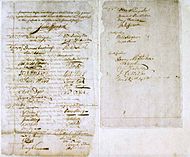Olive Branch Petition facts for kids
Quick facts for kids Olive Branch Petition |
|
 |
|
| Ratified | July 5, 1775 |
| Signers | Second Continental Congress |
| Purpose | Avoiding war between Great Britain and the Thirteen Colonies |
The Olive Branch Petition was an important letter sent by American colonists to King George III of Great Britain. It was adopted by the Second Continental Congress on July 5, 1775, and signed on July 8, 1775. The main goal of this petition was to try one last time to avoid a war between Great Britain and the Thirteen Colonies in America.
Even though the colonists had already planned to invade Canada a week earlier, the petition stated that Americans were still loyal to Great Britain. It asked King George III to help prevent more fighting. However, another document, the Declaration of the Causes and Necessity of Taking Up Arms, was issued on July 6, 1775. This declaration explained why the colonists felt they needed to fight, making the petition's success in London very unlikely. In August 1775, the British government officially declared the colonies to be in rebellion. King George III refused to even read the petition before calling the colonists traitors. This rejection meant that the hope for peace was gone.
Contents
Why Was It Written?
A Call for Peace from the Colonies
In May 1775, the Second Continental Congress met in Philadelphia, in a building now known as Independence Hall. Most of the delegates there, like John Dickinson, wanted to find a peaceful solution with King George III. They hoped to avoid a full-scale war.
However, a smaller group of delegates, led by John Adams, believed that war with the British was unavoidable. They did not support Dickinson's efforts for peace. Instead, they waited for the right moment to encourage the Thirteen Colonies to fight for American independence.
Because this smaller group stepped back, Dickinson and his supporters were able to move forward with their plan for peace. They wanted to try and fix the problems with Great Britain.
Who Wrote the Petition?
John Dickinson was the main writer of the Olive Branch Petition. Other important figures like Benjamin Franklin, John Jay, John Rutledge, and Thomas Johnson also helped write the document.
Dickinson explained that the Thirteen Colonies were not trying to become completely separate from the British Empire. Instead, they wanted fairer rules for trade and taxes. He asked King George III to create a lasting peace between Great Britain and the colonies. This peace would ensure good relations for future generations. He suggested starting by canceling the Intolerable Acts, which were a set of harsh laws imposed by the British.
The petition mentioned twelve of the thirteen colonies, with Georgia being the only one not included. It was approved on July 5 and signed by John Hancock, who was the President of the Second Continental Congress, and representatives from those twelve colonies. On July 8, 1775, the petition was sent to London. It was carried by Richard Penn and Arthur Lee.
Today, this important letter is kept safe in the National Archives in London. Dickinson hoped that the news of the recent Battles of Lexington and Concord, along with this "humble petition," would convince the King to offer a compromise or start talks.
What Happened Next?
The King's Rejection and a Shift Towards Independence
King George III's refusal to even consider the Olive Branch Petition was a turning point. It gave John Adams and others the chance they needed to argue for the colonies' full independence. They pointed out that the King was unwilling to listen to the colonists' complaints.
This made many people in the Thirteen Colonies realize that peace was unlikely. They saw only two real choices: either become completely independent, which would almost certainly mean war with the British, or fully accept British rule.
Thomas Paine further explained these ideas in his famous pamphlet, Common Sense. This widely read pamphlet was published in January 1776. Six months later, the Second Continental Congress officially adopted and published the Declaration of Independence. This historic document, mostly written by Thomas Jefferson, listed the many complaints of the Thirteen Colonies and made a strong case for their independence.
See also

